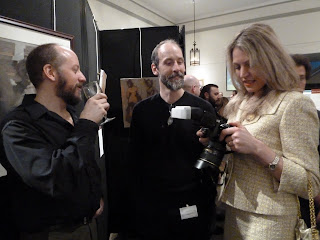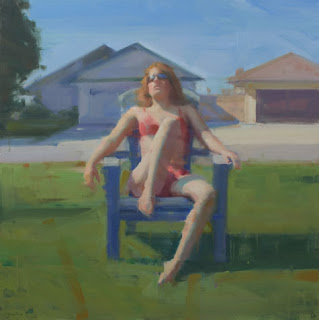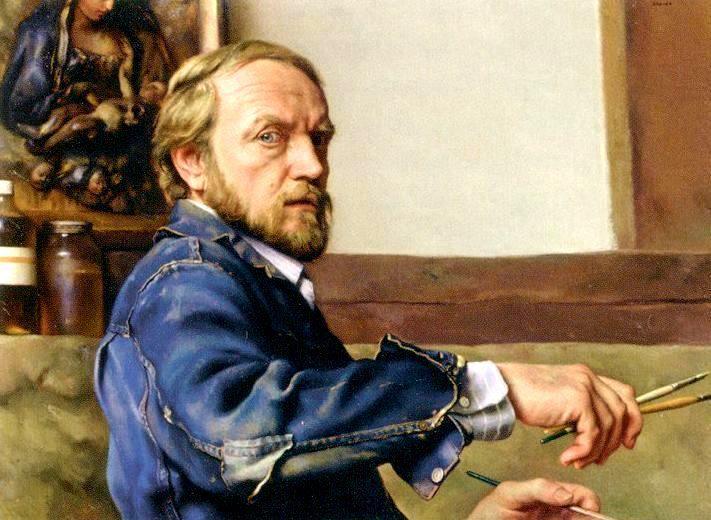Why do we paint?
A friend and colleague of mine once observed that I like to have fun…..that is absolutely the truth. I have often said to students that if you are not having fun, you are doing something wrong. Painting is hard work, but the reason I paint is because I love it, enjoy it, and can’t live without it. The day it stops being fun and rewarding, is the day I will quit, and go get a job at Walmart, as a register clerk!!
Yesterday I found myself saying this to the students in the Level 3 figure painting class that I teach with Leona Shanks. After two years of grueling exercises that include 1-minute gesture drawings, value-studies in charcoal, as well as black and white paint, and a process that has been dubbed “Duo-tone” that utilizes an extremely limited palette, and three semesters of color-study……they are then placed into a figure-painting class, where we teach them to start building paintings…….which is easy…….right???
Along with working in our chosen Incamminati manner of big shapes to small shapes, technical mastery and execution, which gets my total-hands-down-approval, I find myself concerned about the student’s (a.k.a.: the budding painter) ability to have fun. Fun involves the creative process, inventiveness, originality, authenticity, and joy in one’s work, to name a few.
The way that I remedy frustration, despair, and even boredom within the realms of my work is simple: I start standing back and start squinting…..(I said it was simple!) This starts to engage me physically and leads me to getting pumped up about my painting process. We emphasize these two actions all the time here at Incamminati, although, of course we didn’t invent it. The painter, Giovanni Francesco Barbieri (1591-1666), was, and is still, known as Guercino -- "the Squinter”. Nelson (Shanks) has been known to say, “Paint what you see when you squint.”
![]() |
Giovanni Francesco Barbieri
Feb. 8, 1591 - Dec. 22, 1666
|
|
Okay……so painting is supposed to be fun…..says I……it also has to have meaning for me, in order to keep me mentally enthused and involved. Here is where I quote something Leona read in class today from “Baroque and Rococo Art”, c.1964, by Germain Bazin: “The figurative arts of the Baroque period, especially in Italy, are governed by an aesthetic that considered art as a means of expressing the passions of the soul. Psychology made considerable progress in the seventeenth century, and the problems of the passions pre-occupied a number of philosophers. Biologists laid down the first principles of physiognomy, and several artists or critics formulated treatises on expression, one of the most famous of these being by the French painter Charles Le Brun. These treatises indicate how the technique of art should render the various passions-love, suffering, anger, tenderness, joy, fury, warlike ardour, irony, fear, contempt, panic, admiration, tranquility, longing, despair, boldness, etc.” Well….there you have it!
![]() |
Giovanni Francesco Barbieri
David with the Head of Goliath |
|
|
|
There are two other elements that, in my opinion, need to be included in the process of painting: How about truth and beauty? I do not think that these two elements are antiquated. I once did a painting of a crumbled up paper bag that I found interesting and beguiling. Someone thought that it was garbage (the paper bag…not the painting!) and threw it away(again…the paper bag!). Thus, the title of the painting was begat, “Trash.”
So, why paint? I think the above mentioned are some good reasons…..and I would love to hear why others do, and what keep them excited about painting.
I’m going to end this with a favorite quote of mine:
"It is impossible to have a great life unless it is a meaningful life, and it is very difficult to have a meaningful life without meaningful work. Perhaps then you might gain that rare tranquility that comes from knowing that you've had a hand in creating something of intrinsic excellence that makes a contribution. Indeed, you might even gain that deepest of all satisfactions knowing that your short time here on this earth has been well spent, and that it mattered." Jim Collins, From Good to Great





























 He Self-portrait, Nelson Shanks, 1987.
He Self-portrait, Nelson Shanks, 1987.
